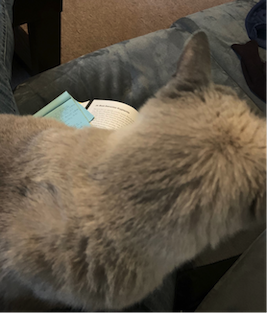Book Review of Make Time Authored By Jake Knapp and John Zeratsky
By Lauren Benoodt, PhD Candidate in Biophysics, Structural & Computational Biology
Make Time is a take on how to avoid distractions and be more focused on what’s really important from two of the people who helped to develop some of the biggest distractions, Gmail and YouTube. This book is written in a very accessible manner including some snarky footnotes that help keep the reader engaged. The underlying ideas of the book aren’t really new, most are either old ideas or common sense advice wrapped up in new packaging. The main ideas involve avoiding the Busy Bandwagon and Infinity Pools. Busy Bandwagon is a term for the constant pressure of doing more to increase productivity, which leads to more things to do at an ever-increasing pace. Infinity Pools are those distractions that suck up ridiculous amounts of time due to the fact that they are constantly refreshing, such as email, news sites, and social media. There are some radical ideas outlined in this book as well, the most drastic being the extent to which the authors recommend unplugging from the constant distraction of the Internet. It is difficult to imagine deleting email and web browsers from a phone. There are also ideas that seem more attainable, such as advice for how to be more present in the moment and not getting distracted by work when not at work.
Make Time consists of four major parts; Highlight, Laser, Reflect, and Energize. These sections include many ideas for how to fulfill that part of the plan, stressing that no one needs to use all of the suggestions. In fact, some suggestions are included that neither of the authors use. The goal is that through experimentation, each reader can develop the plan that works best for their specific needs and preferences. The ideas that are implemented by the authors generally include anecdotes or comments that make them seem more reasonable, even when the suggested idea is something extreme like not having an Internet connection at home.
The most useful section seems to be Highlight, which is a way of thinking about how to make a plan each day so that each day feels meaningful. Essentially, a Highlight is a medium-sized task that takes from 60-90 minutes, long enough to accomplish something meaningful but not so long that a break is required. Importantly, the task will give a feeling of accomplishment or bring joy. There are also many suggestions for how to choose a Highlight, how to prioritize tasks, and how to make sure that each day includes time to accomplish a Highlight. It is also stressed that the Highlight isn’t the only thing that should be completed in a day, but should be the most important.
The second section, Laser, is all about focus and avoiding distractions. This is where the authors start to expand on some of their more extreme ideas. Some make a lot of sense, including setting up barriers that make it more difficult to access distracting apps and websites, or having device-free nights. Others seem more life altering, such as deleting almost everything from a phone, including a web browser, to not get distracted by it. It could be that these extreme measures are necessary for some people, including the authors, but they don’t seem like they will fit in with the way most people want to live their lives.
The most ridiculous ideas were reserved for the Energize portion of this book. The section begins by introducing a caveman named Urk. This idealized portrayal of early humanity is supposed to exemplify how modern humans should shape their lives. Returning to a schedule that is in line with how an idealized hunter-gatherer would live. Apparently, this means eating less frequently because food has to be caught, and ignoring the gathering aspect. Although snacking is offered as an option, it does not include a reference to Urk. There is also a section on exercise, which of course includes suggestions on how to lift things other than weights because Urk would have lifted real objects, like tables or gallon jugs, not weights. There is also the troubling assertion that everyone needs to find their “tribe.” This term is very controversial and isn’t something appropriate for a self-help book. Unless someone is a member of an actual tribe, the word should be avoided. There are some good points about timing caffeine intake and making sure to move and get enough sleep, but this section has some outlandish and offensive claims that really took away from any good advice the Energize portion contained.
Finally, the section on Reflect was very short and basically just said to document what is working and what isn’t in your own journey to increase both productivity and joy in your life.
The first half of this book was very engaging and was full of ideas that I intend to experiment with implementing in my own life. The rest of the book has some major flaws that make it more difficult to take seriously. The overall approach the authors take that no one is perfect and they aren’t here to say they have developed the perfect system that will work for everyone is admirable. The writing is accessible and easy to read, with enough humor to be engaging. Unfortunately, some of the sections including things like a happy-go-lucky caveman who lives an idealized life of wandering, catching food, sleeping peacefully every night, and living in a happy commune with other cave-people takes away from the book as a whole. If you read this book, try to focus on what resonates with you and do your best to ignore the flaws.
Figure 1: An attempt to read the section on avoiding distractions.

Tracey Baas |
12/16/2019
You may also like